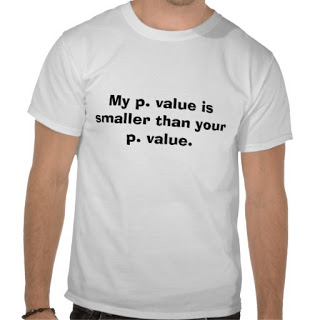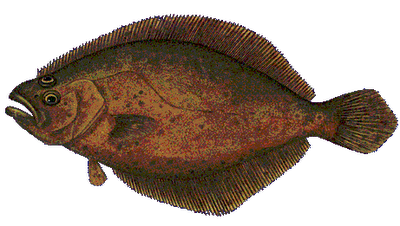Why not 0.06?

Steve Accera asked me an interesting question a few months back. Why is 0.05 the cut-off for a p-value to be considered statistically significant?
To understand the answer to this question, we first have to talk about how to interpret a p-value in the first place. For the expanded explanation, click here. Read More...
How many sprinters does it take to change a lightbulb, or what about important but not significant?

I often have discussions with non-methodologists about statistics and research methods. What can I say, it’s what I do. Statistics is one of those things that everyone has to learn, but most people feel they just don’t understand. So, instead of trying to understand it, they create hard-and-fast rules for themselves to get around it. It’s like chronic double-clickers; you know, that one person you know at work or in your family that double-clicks EVERYTHING, and doesn’t know how to right-click? Generally, it’s people who don’t understand, or aren’t comfortable with computers. They know that some things require double-clicks and it seems to work most of the time, so instead of figuring out that hyperlinks only need one click, they just double-click everything. And they use the menus for everything, including cutting and pasting, because they find CTRL-C and CTRL-V to be too advanced, and even after you show them several times that, “Hey, look how much faster it is to do it this way!” they say something like, “That’s too complicated for me,” but won’t relinquish the mouse or keyboard to you, and then still complain that, “It takes forever to do that on a computer.” And no, this is definitely not my dad. In any way whatsoever. In the research world, it’s similar–people who ONLY use ANOVAs, or rely on normality statistics to figure out if a distribution is normal (just graph it!) for instance…but I’m getting off topic.
There is the argument that statistics limit progress, or that the requirement for something to be statistically shown is restricting because there can be small, but important effects in small populations, therefore making it mathematically very difficult to “obtain” a p-value less than 0.05. Read More...
Just because it’s brown, doesn’t mean it’s chocolate

This blog entry comes courtesy of John Woodslave who posted the link on my Facebook page.
Martin Bland’s “How to Upset the Statistical Referee” should be mandatory reading for all researchers. It’s short, gets to the point and, if everyone paid ACTUAL attention to it, would kill this blog. Read More...
Aerobic exercise vs weights. Who will win?

There is no question that diet and exercise both play a role in fat/weight loss. Schools of thought range from the “it matters more what you eat” camp to the “it matters more how much you move with subgroups ranging from the “it matters how many calories you eat” camp to the “it matters if you do weights” camp and then the all-popular, “just move more” vs. “move, but move really really fast in short intervals of time” camps.
Jen Sinkler of Experience Life magazine brought this study to my attention, because I belong to the, “it matters if you do weights and probably doesn’t matter much if you move more, whether at a steady pace or really really fast in burst intervals.” camp ((mostly out of laziness and abhorrence of “cardio”) Read More...
Flukes–more than fish.
 In January this year, I was in Cancun at a conference (I know, life is harsh). We were traveling from the hotel to the conference and my friend David gave me half a peso back in change because I had lent him too much for bus fare. I said flippantly that he could keep the “half-cent”. He pointed out to me that half a peso was more than half a cent, and was, in fact, 5 cents, or a nickel. I said it was barely more, and he rebutted that it was TEN times more. It was then that I realized this was a very good illustrative example of how a statistically meaningful difference still doesn’t translate into buying a pack of gum.
In January this year, I was in Cancun at a conference (I know, life is harsh). We were traveling from the hotel to the conference and my friend David gave me half a peso back in change because I had lent him too much for bus fare. I said flippantly that he could keep the “half-cent”. He pointed out to me that half a peso was more than half a cent, and was, in fact, 5 cents, or a nickel. I said it was barely more, and he rebutted that it was TEN times more. It was then that I realized this was a very good illustrative example of how a statistically meaningful difference still doesn’t translate into buying a pack of gum.
Most of the studies I review for this site fall into two categories: Read More...
Beta-alanine redux: Same question, still no answer. But they still recommend you take it.
 It’s been three years since I’ve written about beta-alanine. I do monitor the literature from time to time to see what’s new in the BA research world. But really, there isn’t anything new. There still is no definitive answer that BA does anything meaningful. The latest BA study not only failed to find anything meaningful, but also failed to plan to find anything meaningful, allowing the gods of statistical probability to decide if the fruits of their labour would be met with reward.
It’s been three years since I’ve written about beta-alanine. I do monitor the literature from time to time to see what’s new in the BA research world. But really, there isn’t anything new. There still is no definitive answer that BA does anything meaningful. The latest BA study not only failed to find anything meaningful, but also failed to plan to find anything meaningful, allowing the gods of statistical probability to decide if the fruits of their labour would be met with reward.
Kern BD, Robinson TL. Effects of beta-alanine supplementation on performance and body composition in collegiate wrestlers and football players. Journal of Strength and Conditioning Research, 25(7):1804-1815, 2011. Read More...
It was bound to happen
 This blog entry is courtesy of Fran Mayo who read an article in “Runner’s World” about some of the benefits of drinking pomegranate juice. It was fairly inevitable that I would get around to talking about pomegranate juice. It is, after all, all the rage right now and POM is currently in the media regarding some dubious health claims.
This blog entry is courtesy of Fran Mayo who read an article in “Runner’s World” about some of the benefits of drinking pomegranate juice. It was fairly inevitable that I would get around to talking about pomegranate juice. It is, after all, all the rage right now and POM is currently in the media regarding some dubious health claims.
There are lots of reasons to drink pomegranate juice. Personally, when it first came out as a commercial product, I thought it was a pure novelty. I mean, have you ever EATEN a pomegranate? It takes FOREVER. The whole idea of juicing enough fruit to make a whole bottle of pure pomegranate juice was just unfathomable. So from my perspective, one of the reasons to drink pomegranate juice is because you can. All that pomegranate-y taste without the painstaking work. Read More...
Feel the PUMP! Um..that’s it.
First off, I LOVE how this article starts, “The use of nutritional supplements continues to increase with athletes and recreationally active trainees…” That’s right, you gym rats (me included); we’re not athletes. Quit pretending. It’s okay.
Snarkiness aside, I’ve been wanting to discuss nitric oxide or NO supplements (as well as pre-workout drinks) for a long time; but oddly enough, the literature was incredibly sparse on the topic in terms of studies involving humans and outcomes training individuals would be interested in. NO-type ingredients seem to be in everything, to the point where you don’t have to _decide_ to take an NO-related ingredient, you probably just are, particularly if you’re taking anything that is designed as a pre-workout supplement. In fact, it’s amazing that they can stuff more than 30 ingredients into a single pre-workout drink such that it will still fit into a couple of scoops. Read More...
An iPod Shuffle! For almost free! (Oh, and protein timing)
Eating protein before and after workouts has been touted to be one of the most important things you can do to decrease DOMS, increase protein synthesis, prevent protein breakdown, and in this article, increase your resting metabolic rate. The other claims…maybe I’ll tackle those another day (This post is hellishly long enough) Read More...
More is not better–when statistics turn bad (it’s just not as entertaining as when animals do)
As with everything, more is not usually better. In statistics, more actually makes you more prone to being accidentally wrong (or, in statistics-lingo, spurious). Today, I’d like to talk about a basic concept that is taught to students in their introductory statistics courses (and hence, you would think, most researchers): The effect of multiple significance testing. Read More...
